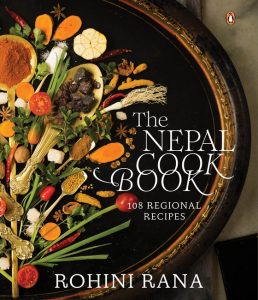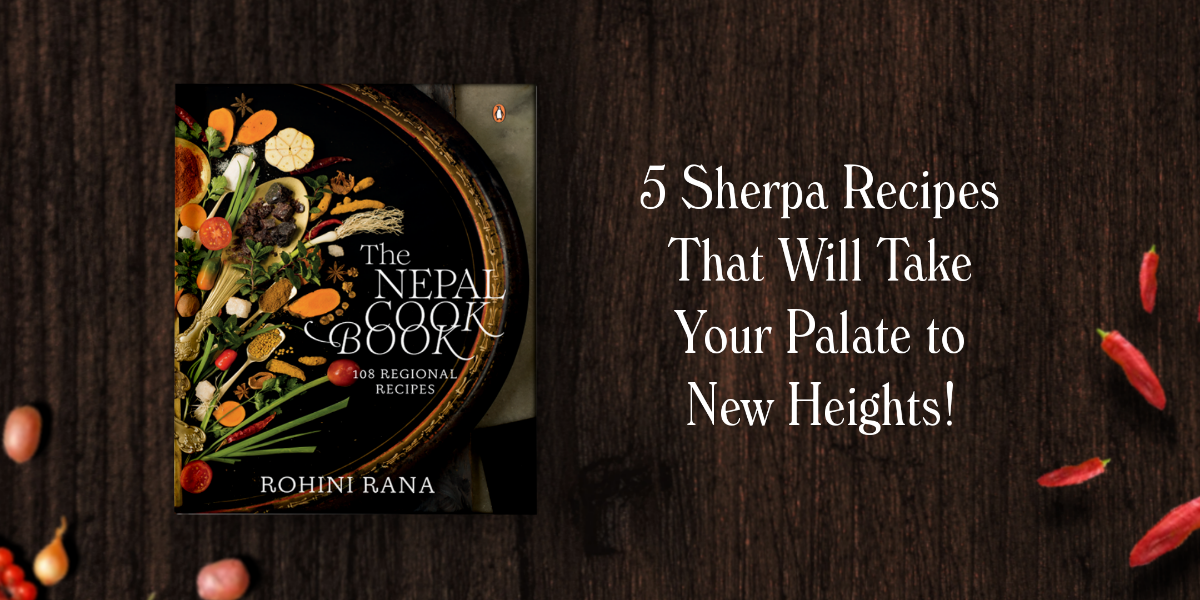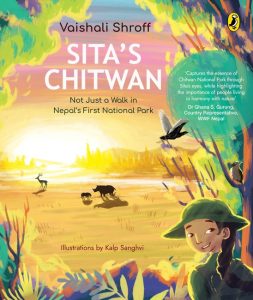Buckle up and prepare for a mouthwatering journey with The Nepal Cookbook by Rohini Rana. From Kur flatbread to Rilduk potato soup, savor the flavors of these 5 Sherpa recipes (and more) and elevate your dining experience with each delicious bite.
Get ready to soar to culinary heights like never before!

***
The famous Sherpa community hails from the mountainous region in Tibet and even further, in Mongolia, migrating to settle in the Sagarmatha (Everest) area of the Solukhumbu valley. Sherpa means, people from the east. From their traditional home, they spread out over the eastern hill districts and have earned a glorious name in the history of global mountaineering as the most hardy and resilient people. After the epic scaling of Mt Everest by Tenzing Norgay and Edmund Hillary in 1953, the Sherpa community has catapulted into prominence as mountaineers and guides and their economy has been vastly uplifted thanks to their skills. Having lived in this mountainous region for years, they are naturally acclimatized to great physical feats at high altitudes, carrying heavy loads and scaling high mountains without the use of oxygen. Pasang Lhamu Sherpa became the first Nepali woman to scale Mt Everest in 1993; she unfortunately died on the slopes during her descent.
The Sherpas retain much from their Tibetan heritage but have integrated well into the Nepali mainstream. They are devout Buddhists and have built beautiful monasteries all over the Khumbu region. The most famous being Tengboche, nestling in the oldest Sherpa village in Nepal, one of the highest monasteries in the world, resplendent with beautiful paintings and thangkas. Lhosar, Tibetan New Year, is celebrated with singing, dancing and copious amounts of feasting.
One of the Sherpas’ main occupations is animal husbandry of yak, mountain sheep and cattle, grazing them on the alpine grassland slopes. They engage in sporadic farming, growing cereals like maize, barley and wheat, vegetables like potato, radish and beans–these are the staple foods of the Sherpas. Their food culture is similar to Tibet’s, but they have assimilated their own traditional dishes such as fresh and dried yak meat, hand pulled noodles, potato preparations, steaming radish and bean stews, which are delicious and keep them snug and warm during the cold climate of their region.
***
Kur
Sherpa Flat Bread
Preparation time: 30 minutes
Serves: 8
INGREDIENTS
- 2 cups plain flour
- 1 tbsp. baking powder
- ½ tbsp. salt
- water
PREPARATION
Mix all the ingredients and knead into a smooth dough, cover and let it rest for ½ hour.
Divide into equal-sized balls and roll out into 1⁄4-inch thick discs.
Cook in a warm pan on both sides until they turn golden brown.
Serve topped with yak butter.
***
Rilduk
Sherpa Potato Soup
Preparation time: 30 minutes
Serves: 8
INGREDIENTS
- 2 tbsp. ghee
- 6 boiled potatoes
- 1 sliced onion
- 2-3 chopped tomatoes
- 5 cloves garlic
- 3-4 red chillies
- 1 cup grated cheese
- 20 timur seeds
- ½ cup chopped green onions
- Salt to taste
PREPARATION
Boil and grate the potatoes, place in a large wooden mortar, keep pounding till their elasticity is seen, keep aside.
Heat oil and sauté the onions till a light golden brown.
Crush the timur seeds, garlic and red chillies in a mortar and pestle to a coarse consistency.
Add this ground mixture to the oil and cook for 2-3 minutes.
Add the chopped tomatoes to the pan and stir for 2 minutes.
Add salt, water and chopped green onions to the soup and cook till it boils.
Make small balls of the potato mixture and add to the boiling soup.
Cook till the balls float on top of the liquid.
Add the grated cheese, let it melt, serve hot!
***
Aaloo Phing
Potato Curry with Glass Noodles
This recipe was originally prepared with yak meat, now buff is more commonly used
Preparation time: 45 minutes
Serves: 6
INGREDIENTS
- 1 cup meat cubes with bones (optional)
- 2 cups potatoes cut into cubes
- 1 cup carrots cut into cubes
- 1 tsp. garlic paste
- 1 tsp. ginger paste
- 2 tbsp. chopped onions
- 25 g phing noodles
- 1 tsp. coriander powder
- 1 tsp. cumin powder
- ½ tsp. chilli flakes
- ½ tsp. turmeric powder
- 2 tbsp. oil
- Salt to taste
PREPARATION
Soak the noodles in hot water for 15 minutes.
Heat the oil in a pan and add chopped onions, garlic and ginger paste, sauté for 2 minutes.
Add the meat, chopped potatoes and carrots and dry spices, stir for 2 minutes till the vegetables are well coated with the oil and spices.
Add 2 cups of water and cover and cook on medium heat till the meat and potatoes are cooked.
Add the noodles, cook for a further 5 minutes, serve hot, garnished with chopped green onions.
Any meat of your choice like yak, beef, chicken or mutton can be used.
***
Shyakpa/Thukpa
Sherpa Soup
Shyakpa and thukpa are Sherpa soups, very similar in taste and ingredients.
The main difference between them being that shyakpa is made out of thick hand-pulled noodles of different shapes, while thukpa is spicier and made out of long and thin spaghetti-like noodles.
This hot, wholesome soup is perfect on a cold, wintry evening.
Preparation time: 45 minutes
Serves: 6-8
INGREDIENTS
HANDMADE NOODLES
- 2 cups refined flour
- 1 tbsp. oil
- Water
SOUP
- 2 cups yak sukuti or fresh yak/mutton meat
- 1 cup potatoes
- ½ cup carrots
- ½ cup radish
- 1 bunch bak choy
- ½ cup sliced onions
- 2 tbsp. coarsely ground ginger
- 4 tbsp. coarsely ground garlic
- 1 tbsp. coarsely ground red chillies
- ½ tsp. turmeric powder
- 3 tbsp. oil
- Salt to taste
GARNISH
- Green onions
- Chilli oil
- Timur Chope
PREPARATION
Make smooth dough out of the fl our, water and oil, like one would for momos; keep aside.
Chop the meat and vegetables into 1 inch cubes. Heat oil and sauté the roughly crushed garlic and ginger, add the sliced onions with a pinch of turmeric powder. Once the onions are translucent, add the sukuti or meat and cook till it is brown. Add all the vegetables, except the bak choy and cook for a few minutes.
Add water or stock and cook till meat and vegetables are half-cooked, add the handmade noodles, breaking off pieces of the rolled out dough to your preferred size.
Just before serving, add the bak choy and cook for 2 minutes. Garnish with chilli oil and green onions.
THUKPA
Use thin noodles and chop the vegetables small, use minced meat instead of meat cubes or sukuti.
This soup is spicier than Shyakpa so add chillies and timur chope (sichuan pepper powder) according to your taste.
***
Phapchung
Butter Tea
Preparation time: 20 minutes
Serves: 4
INGREDIENTS
- 200 grams Chinese tea
- 2 ½ cups milk
- 2 cups water
- 250 grams butter
- 1 tsp. salt
PREPARATION
Boil tea in water for 10-15 minutes, strain and add milk, butter and salt. Place in a blender or dhongmu (wooden vessel to make tea), blend and serve hot.
***
Get your copy of The Nepal Cookbook by Rohini Rana wherever books are sold.









